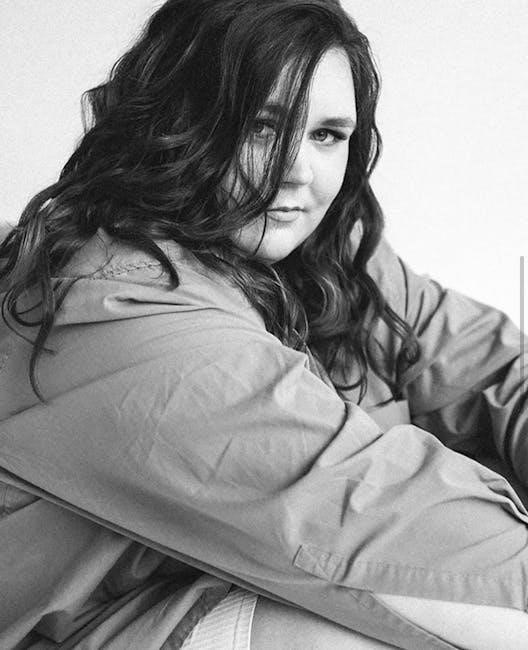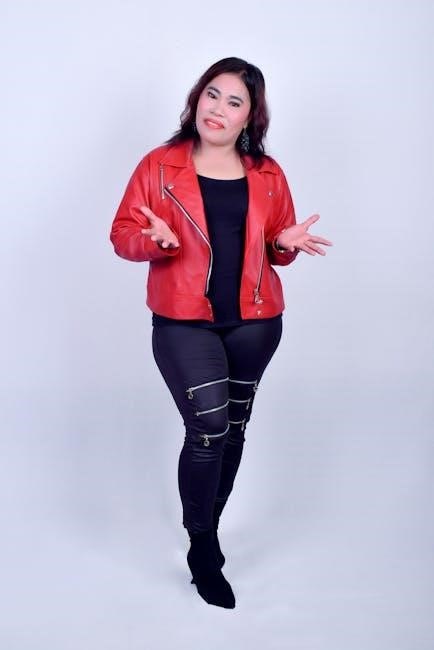Discover how to measure your body and jacket accurately to find the perfect fit․ Use size charts to avoid returns and ensure comfort․ Learn to choose styles that flatter your silhouette and understand fabric impact on sizing․
Understanding Body Measurements
Accurate body measurements are essential for determining your jacket size․ Start by measuring your bust‚ waist‚ and hips to ensure the best fit․ Use a flexible tape measure and keep it level for precise results․ For jackets‚ focus on your bust measurement‚ as this is often the primary sizing factor․ Wrap the tape around the fullest part of your bust‚ keeping it parallel to the floor․ Your waist measurement is taken at the narrowest point‚ typically just above your belly button․ Hip measurements are taken around the widest part of your hips‚ usually 7-9 inches below your waistline․ Additionally‚ measure your sleeve length from the center back of your neck to your wrist to ensure a comfortable fit․ Understanding these measurements will help you interpret size charts accurately and choose a jacket that flatters your silhouette․ Always measure over the clothing you plan to wear under the jacket for the most accurate fit․
Measuring Your Jacket
To ensure the best fit‚ measure your jacket accurately when it’s laid flat on a smooth surface․ Begin by buttoning up the jacket and smoothing out any wrinkles․ Measure the chest width by placing the tape measure across the front‚ from one armpit seam to the other․ Next‚ measure the waist at the narrowest point‚ typically just below the bust․ For the shoulder length‚ measure from the base of one shoulder seam to the other․ The sleeve length is measured from the shoulder seam to the cuff․ Finally‚ measure the overall length from the base of the collar to the hem at the back․ Compare these measurements to your body measurements to determine the best fit․ Ensure the tape measure is held firmly but not stretched too tight‚ as this can lead to inaccurate sizing․ Taking precise measurements helps you choose a jacket that aligns with your body proportions and desired style․
Importance of Size Charts
Size charts are essential for ensuring a seamless shopping experience‚ especially when purchasing jackets online․ They provide a standardized reference point‚ helping customers select the most flattering and comfortable fit based on their body measurements․ By reducing guesswork‚ size charts minimize the likelihood of ill-fitting purchases and subsequent returns‚ which is beneficial for both consumers and retailers․ They also account for brand variations‚ as sizing can differ significantly between labels․ A well-crafted size chart empowers customers to make informed decisions‚ boosting their confidence in their purchases․ Additionally‚ size charts promote consistency across product lines‚ ensuring that customers receive garments that align with their expectations․ This tool is particularly vital for online shoppers who cannot try items before buying‚ making it a cornerstone of a positive and hassle-free shopping experience․ By relying on accurate size charts‚ customers can enjoy jackets that fit perfectly and enhance their overall style․
How to Read a Size Chart
Reading a size chart effectively is crucial for selecting the right jacket fit․ Start by identifying your measurements‚ such as bust‚ waist‚ and hip‚ and compare them to the chart provided․ Most charts list sizes numerically or alphabetically‚ with corresponding body measurements․ Pay attention to whether the measurements are in inches or centimeters․ Match your body measurements to the closest size range to determine your ideal fit․ If your measurements fall between sizes‚ consider whether you prefer a snug or relaxed fit to decide between sizing up or down․ Some charts also include additional details like sleeve length or chest circumference‚ which can further refine your choice․ Always check if the chart is specific to the brand or style‚ as sizing can vary․ By carefully aligning your body measurements with the size chart‚ you can ensure a comfortable and flattering fit for your jacket․
Factors Affecting Jacket Fit
Several factors influence how a jacket fits‚ including fabric type‚ personal body proportions‚ and style design․ Fabric plays a significant role‚ as materials like stretchy knits offer more flexibility than rigid fabrics․ Body shape‚ such as petites or plus sizes‚ can affect how a jacket sits on the body․ Additionally‚ personal preferences for a snug or relaxed fit impact sizing choices․ Jacket styles‚ like cropped or oversized designs‚ are tailored to specific body types‚ so understanding your silhouette is key․ Even small details‚ such as shoulder slope or arm length‚ can alter the fit․ Layering intentions also matter‚ as jackets meant for bulky sweaters require a looser fit․ Brand sizing variations further complicate the process‚ as measurements can differ significantly between labels․ Accurate body measurements and awareness of these factors ensure a jacket that flatters and comforts․ Consider these elements to make informed decisions when selecting your perfect jacket․

Choosing the Right Style
Selecting the right jacket style involves considering your body type‚ personal preferences‚ and the occasion․ For petite frames‚ cropped or tailored jackets create a balanced look‚ while taller women may prefer longer‚ oversized styles; Hourglass figures can accentuate their curves with fitted jackets‚ whereas rectangular body types benefit from structured or padded shoulders․ The occasion also matters—leather jackets are ideal for edgy‚ casual looks‚ while tailored blazers suit professional settings․ Fabric choice is crucial too‚ as lightweight materials like denim or linen are perfect for spring‚ and thicker fabrics like wool or down are better for winter․ Additionally‚ think about versatility; a neutral-colored jacket can easily pair with multiple outfits․ Personal style plays a significant role‚ so choose a jacket that reflects your aesthetic‚ whether modern‚ vintage‚ or minimalist․ By aligning the jacket style with your lifestyle and body proportions‚ you ensure a flattering and functional addition to your wardrobe․ This step ensures your jacket is both stylish and practical for years to come․

How to Use the Size Guide
Using a size guide effectively ensures a perfect fit for your jacket․ Start by carefully measuring your body according to the guide’s instructions‚ focusing on key areas like bust‚ waist‚ and hips․ Compare these measurements to the size chart provided‚ matching them to the closest size․ Pay attention to fit descriptions‚ such as “slim fit” or “relaxed‚” to align with your preference․ If your measurements fall between sizes‚ consider sizing up for comfort or down for a tighter fit‚ depending on the style․ Fabric type also plays a role‚ as stretchy materials may allow for a smaller size‚ while rigid fabrics require a bit more room․ For accuracy‚ use a flexible tape measure and stand up straight during measurements․ Double-checking your measurements ensures you select the right size․ Remember‚ sizing can vary between brands‚ so always refer to the specific guide for the jacket you’re purchasing․ By following these steps‚ you can confidently choose a jacket that fits perfectly and meets your needs․
Tips for Accurate Measurements
Accurate measurements are crucial for finding the perfect jacket fit․ Use a flexible tape measure and ensure it’s level and not too tight or loose․ Measure over the undergarments and bra you normally wear for consistency․ Stand up straight with your arms relaxed by your sides․ For the bust‚ measure around the fullest part‚ keeping the tape parallel to the floor․ The waist measurement should be taken at the narrowest point‚ usually just above the hipbone․ For the hips‚ measure around the widest part‚ about 7-9 inches below the waistline․ If measuring a jacket‚ lay it flat and double-check the shoulder‚ chest‚ and length measurements․ Consider your personal fit preference—looser or fitted—and adjust accordingly․ Take multiple measurements to ensure accuracy‚ as body measurements can vary slightly․ Always refer to the size chart specific to the brand and style you’re purchasing; If your measurements fall between sizes‚ consider sizing up for a looser fit or down for a more tailored look․ Lastly‚ fabric type can affect fit‚ so factor that into your decision for the best result․

Common Sizing Mistakes
When selecting a jacket‚ several common sizing mistakes can lead to poor fit․ One major error is not consulting the size chart provided by the brand‚ assuming your usual size will apply․ Another mistake is guessing your size based on previous purchases without measuring․ Many women measure their body incorrectly‚ such as pulling the tape too tight or not keeping it level․ Additionally‚ some individuals measure over bulky clothing‚ which can distort results․ Ignoring fabric type is another oversight‚ as stretchy materials may fit differently than rigid ones․ Assuming all brands size similarly is a common pitfall‚ as sizing can vary significantly․ Not considering personal fit preferences‚ such as preferring a loose or tailored style‚ can also lead to dissatisfaction․ Lastly‚ some shoppers fail to account for layering needs‚ such as fitting over sweaters or blazers․ Avoid these mistakes by carefully following the size guide and double-checking your measurements for the best fit․
Brand Variations
One of the most challenging aspects of finding the right jacket size is navigating the differences between brands․ Each brand may have its own sizing standards‚ which can vary significantly․ For example‚ one brand’s size 8 might be equivalent to another brand’s size 10․ European‚ American‚ and UK sizing systems further complicate things‚ as they often have different measurement guidelines․ Some brands‚ like Holland Cooper‚ craft items to fit consistently across their product lines‚ while others may offer more tailored or relaxed fits; Additionally‚ fabric type and design can influence how a jacket fits‚ even within the same size range․ To avoid confusion‚ always refer to the specific size chart provided by the brand for the item you’re interested in․ Pay attention to customer reviews‚ as they often highlight if a brand runs small‚ large‚ or true to size․ This will help you make informed decisions and find the perfect fit for your body type and personal style․
Fabric and Fit Considerations
Fabric and fit are crucial factors in determining the comfort and appearance of a jacket․ Different fabrics have varying levels of stretch‚ thickness‚ and drape‚ which can affect how a jacket fits․ For instance‚ stretchy materials like spandex blends may offer a snug‚ form-fitting silhouette‚ while loose-weave fabrics like wool or tweed may provide a more relaxed fit․ Leather jackets‚ on the other hand‚ often have a structured fit that may feel tighter due to the rigidity of the material․ Understanding the fabric type is essential to choosing the right size‚ as some materials may require sizing up or down for optimal comfort․ Additionally‚ the intended use of the jacket influences fit—active wear may need a closer fit‚ while casual or oversized styles allow for layering․ Always consider the fabric description and fit style when selecting a size to ensure the best possible fit for your needs and preferences․ This ensures a flattering and functional garment tailored to your lifestyle and body type․
When to Size Up or Down
Deciding whether to size up or down depends on your personal fit preferences‚ body measurements‚ and the jacket’s design․ If your measurements fall between sizes‚ consider whether you prefer a snug or relaxed fit․ For instance‚ if you plan to layer thick sweaters underneath‚ sizing up ensures comfort and mobility․ Conversely‚ if you want a tailored look or the jacket is designed to be form-fitting‚ sizing down may be appropriate․ Fabric stretch also plays a role—jackets with elastic materials can accommodate tighter fits‚ while non-stretch fabrics may require sizing up for comfort․ Pay attention to specific features like darts or seaming‚ which can affect how the jacket drapes on your body․ Ultimately‚ the goal is to balance style and comfort‚ ensuring the jacket moves with you without feeling restrictive․ Refer to size charts and product descriptions to make informed decisions tailored to your needs and the jacket’s intended use․ This ensures the best possible fit for both aesthetics and functionality․
Online Resources and Tools

Utilize online resources to simplify your jacket sizing journey․ Many brands‚ like ASOS and Holland Cooper‚ offer detailed size charts on their websites․ Use body measurement calculators to determine your size accurately․ Google’s advanced search tips can help you find specific sizing guides quickly․ Websites like Amazon provide customer reviews and fit feedback‚ aiding your decision․ Some platforms offer virtual try-on tools‚ allowing you to visualize the fit without physical trials․ Additionally‚ sewing communities and fashion blogs often share tips for measuring and fitting jackets․ Tools like size conversion charts are handy for international shopping․ Don’t forget to check brand-specific guides‚ as sizing can vary․ By leveraging these online tools‚ you can make informed decisions and reduce the risk of ill-fitting purchases․ Always cross-reference multiple sources for consistency and accuracy to ensure the best fit for your new jacket․ These resources empower you to shop confidently‚ both online and in-store․